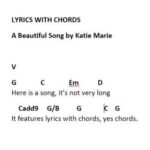“Yesterday” by The Beatles is one of the most iconic and beloved songs of all time. Its simple yet poignant melody and heartfelt lyrics resonate with listeners across generations. For aspiring guitarists, “Yesterday” is also an excellent choice for learning fundamental chords and developing essential playing skills. This guide will break down the Yesterday Guitar Chords, offering a step-by-step approach to mastering this classic tune.
Understanding the Chords in Yesterday
The beauty of “Yesterday” lies in its relatively straightforward chord progression, making it accessible for beginner guitar players. The song primarily uses open chords and some slightly more challenging but common chords, providing a great learning experience. Let’s explore the main yesterday guitar chords you’ll encounter:
-
G Major (G): A foundational open chord, G major is bright and cheerful, forming the root of the song’s key. You’ll use this extensively throughout “Yesterday”.
Alt text: G Major chord diagram, a fundamental guitar chord used in Yesterday, showing finger placement on the fretboard.
-
F# minor (F#m): This minor chord adds a touch of melancholy and depth to the progression. While barre chords can be intimidating for beginners, F#m can be played in simpler forms as you progress.
Alt text: F sharp minor chord diagram, a minor chord adding a melancholic feel to Yesterday, illustrating finger positions.
-
B7 (B dominant 7th): The B7 chord brings a bluesy and slightly dissonant flavor, creating harmonic interest and leading smoothly to the Em chord.
Alt text: B7 chord diagram, a dominant 7th chord introducing a bluesy element to Yesterday, demonstrating finger placement.
-
E minor (Em): Em is another essential minor chord, adding to the emotional depth of the song and providing a contrast to the major chords.
Alt text: E minor chord diagram, a key minor chord in Yesterday, enhancing the song’s emotional depth, showing finger positions.
-
C Major (C): A warm and familiar major chord, C provides a pleasant resolution and is a staple in countless songs, including “Yesterday”.
Alt text: C Major chord diagram, a common major chord in Yesterday, offering a warm resolution, illustrating finger positions.
-
D7 (D dominant 7th): Similar to B7, D7 adds a dominant flavor and creates a strong pull back to the G chord, driving the harmonic movement of the song.
Alt text: D7 chord diagram, a dominant 7th chord in Yesterday, creating harmonic movement back to G, demonstrating finger placement.
-
E minor 7th (Em7): A slightly jazzy and smoother variation of Em, Em7 adds a touch of sophistication and elegance.
Alt text: E minor 7th chord diagram, a jazzy variation of Em in Yesterday, adding sophistication, illustrating finger positions.
-
A7 (A dominant 7th): A7 functions similarly to B7 and D7, creating harmonic tension and resolution within the chord progression.
Alt text: A7 chord diagram, a dominant 7th chord in Yesterday, building harmonic tension and resolution, showing finger positions.
-
A minor (Am): Am is another fundamental minor chord, contributing to the song’s overall emotional landscape, particularly in the chorus.
Alt text: A minor chord diagram, a fundamental minor chord in Yesterday, adding to the emotional landscape, illustrating finger positions.
Strumming Pattern and Song Structure
“Yesterday” can be played with a variety of strumming patterns. For beginners, a simple down-down-up-down-up pattern in 4/4 time works perfectly. As you become more comfortable, you can experiment with more complex rhythms and fingerpicking patterns to add your personal touch.
The song structure is relatively repetitive, making it easier to memorize and play along. It follows a Verse-Verse-Chorus-Verse-Chorus-Verse structure, ending with a simple outro. Pay attention to the chord changes within each section and practice smooth transitions between chords.
Tips for Mastering Yesterday Guitar Chords
- Start Slow: Begin by practicing chord changes slowly and deliberately. Focus on clean and accurate finger placement before increasing speed.
- Use a Metronome: A metronome is invaluable for developing rhythm and timing. Start at a slow tempo and gradually increase it as you improve.
- Listen to the Original Song: Listen to “Yesterday” frequently to internalize the melody, rhythm, and feel of the song. This will help you play with more expression and accuracy.
- Practice Chord Transitions: Smooth transitions between chords are key to playing “Yesterday” fluidly. Practice moving between each chord pair in the song progression.
- Break it Down: If you find a particular section challenging, break it down into smaller parts and practice those sections repeatedly before putting them back together.
Conclusion
Learning “Yesterday” guitar chords is a rewarding journey for any beginner guitarist. It introduces you to essential chords, strumming techniques, and song structure, all within the context of a timeless classic. By following this guide and practicing consistently, you’ll be playing “Yesterday” on your guitar in no time, impressing yourself and your friends with this beautiful and enduring song. Happy playing!


